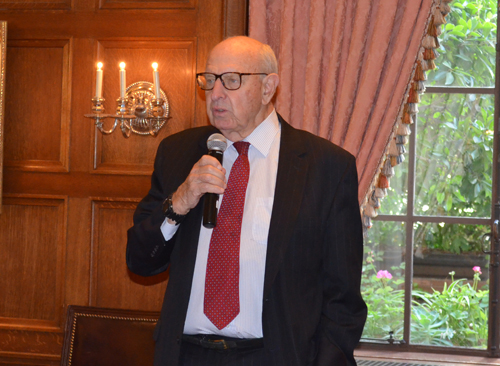
Ambassador Thomas Pickering
The Iranian nuclear deal, which former President Obama regarded as his signature foreign policy achievement, has been pushed into limbo by President Trump who refused on October 13th to recertify the agreement while stopping short of scrapping the pact. “We don’t know where it will end,” said Ambassador Thomas Pickering. “Conflict is not to be ruled out.”
Pickering, a 40-year veteran of the State Department who reached the level of Career Ambassador before retirement, says the gravity of the face-off over the Iranian nuclear deal should not be underestimated. He is a member of the bipartisan Iran Project, which is dedicated to preventing Iran from acquiring a nuclear weapon. He conceded the Iran Deal that was negotiated by Secretary of State Kerry in 2015 was not perfect and had some shortcomings, but also warned that to scrap the deal now could have very negative consequences both in Iran and in the wider Middle East, as well as in North Korea. “Were the US to be seen to be pulling out of the [Iran] agreement, it wouldn’t help with [any talks we might have with] North Korea.”
Iran’s nuclear program started under the Shah, stopped after the Islamic Revolution that brought Ayatollah Khomeini to power and was restarted at a low level in the 1980’s. But in the 1990’s Iran purchased equipment from the Pakistani nuclear arms physicist and proliferator A Q Khan, which was the benchmark for when Iran shifted from research into nuclear isotopes and nuclear energy to a fully-fledged nuclear weapons program, according to Pickering. The US invasion of Iraq prompted the Iranians to suspend their nuclear program in 2003, but enrichment of uranium later was resumed. At the same time, the US was conducting quiet “track two” diplomacy outside official government channels to try to get Iran to halt its weapons program – helped by the mediation of Oman, which has good relations with both Tehran and Washington. Additionally, the US, along with China, Russia and the EU imposed strict sanctions on Iran. This led to the nuclear deal being concluded by Iran and the P6 in July 2015.
The International Atomic Energy Agency (IAEA) has the job of overseeing whether Iran remains in compliance with the deal, and so far they say Iran is not in violation. “But the President has a different view, and he has punted to Congress, who have 60 days to decide on whether to re-impose sanctions or not – so the clock is ticking,” said Pickering. “If the US reneges, the Iranians would be freed from the agreement – they could start enriching again, or they could choose to stay in compliance along with the other members of the P6 (China, Russia, France, the UK and Germany)”.
Pickering said the uncertainty over the Iran nuclear deal compounds the chaos in the Middle East, which has been fed over the years by the Israeli-Palestinian conflict, the Iran-Iraq war, the Arab Spring and the Saudi-Iran confrontation. “We are now approaching Middle East Chaos 5.0,” he said.
He said that Iran’s president Hassan Rouhani “over a period of time has shown his interest in pulling Iran back into the community of nations rather than being an outcast.” Most recently Rouhani has begun arresting senior members of the powerful Republican Guard for corruption, which is a popular move domestically where many Iranians have grown to resent the heavy hand of the Guards. He said the economic reintegration is taking longer than the Iranians had hoped, but that notwithstanding, Rouhani was still popular enough to win reelection to the presidency this year.
Meanwhile Pickering warned of the dangers of the US becoming less engaged in the region. “The US has less and less of a leadership role in the region.” Which only opens the door to China and Russia to expand their influence in what remains the largest oil producing region in the world.
